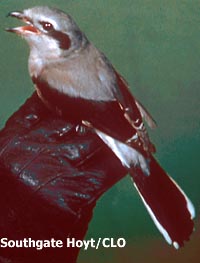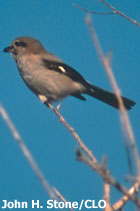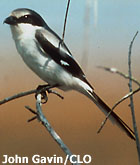
Northern Shrike
(Lanius
excubitor)
Cool fact: Shrikes are the only songbirds to consistently prey on vertebrate animals. They feed on small mammals and birds for much of year and often store uneaten prey by impaling it on thorns. This habit has earned them the nickname "butcher birds."

The Northern Shrike and the similar Loggerhead Shrike are the only two members of the shrike family to be found in North America. Whereas the Loggerhead Shrike nests throughout the West and Southeast, the Northern Shrike nests in the far North. It breeds from Alaska across northern Canada through the Northwest Territories to northern Quebec and central Labrador, as far north as the tree line. The edges of coniferous forests and open willow brush country are preferred habitat. The Northern Shrike is also found in many of the northern regions of Eurasia.
Normally a solitary hunter, it perches atop trees and scans for prey. When prey is sighted, the bird drops from its perch and flies low over the ground, in slightly undulating flight to the attack. It knocks flying victims to the ground with a blow from its bill or seizes them with its feet. Once on the ground, it kills with a series of bites. Like the bills of falcons, shrikes' bills are hooked, with a toothlike structure on the upper mandible and a corresponding notch on the lower bill. Their eyesight is comparable to that of diurnal raptors. Unlike raptors, however, the shrike lacks the powerful talons that hawks use to dispatch their prey. Another hunting strategy is to move through the branches of trees trying to flush birds, which are then pursued. Birds as large as Blue Jays and Mourning Doves may be taken, as well as many smaller birds such as chickadees, Snow Buntings, crossbills, sparrows, and redpolls. Mammalian prey includes lemmings, voles, and mice. Insects such as grasshoppers, crickets, flies, beetles, wasps, and caterpillars are also eaten and may make up to one-quarter of the shrike's diet in season. Prey is often carried to a thorny tree or shrub to be impaled. If it's hungry, the shrike consumes its prey at once, but sometimes food is left impaled for short-term storage.
Northern Shrikes sing a medley of short liquid trills and whistles and harsh notes and often mimic the calls and songs of other birds such as Blue Jays, Gray Catbirds, American Robins, and Song Sparrows. The call is a harsh shek-shek or a grating jaaeg.
Northern Shrikes are migratory, wintering from the southern parts of their breeding range to as far south as northern California, Arizona, and New Mexico through the northern Great Plains and east to Pennsylvania and New Jersey. Numbers in winter vary considerably and may be related to the cycles of small mammals. Christmas Count data from 1900 to 1935 show a distinct cycle of a peak "invasion winter" every 4.2 years, but after 1935, the cycle disintegrates and irruptions have since occurred during different years in the East and West.
Description: The Northern Shrike is a robin-sized bird that is approximately 9.00 to 10.75 inches in length. It is gray above and white below, with a black mask through the eyes and a finely barred breast. The wings are black with white patches, and the tail is black with white at the outer feathers. Immatures are similar to adults, but the mask is faint, and the breast is more heavily barred.
Northern Shrikes are larger and paler than the similar Loggerhead Shrike (L. ludovicianus), and they possess a comparatively longer and more hooked bill. The rump of the Northern Shrike is white; that of the Loggerhead Shrike varies from dark gray to whitish. The barring of the underparts is more distinct and more extensive than the very faint barring of the Loggerhead. The Northern Shrike's mask is narrower and does not extend above the eye nor above the bill; the Loggerhead's mask is a bit broader and extends in a thin line above the bill and eye. The Northern Shrike's bill is bicolored; the Loggerhead Shrike's bill is all black.
The Northern Mockingbird (Mimus polyglottos) is another bird that might be mistaken for a Northern Shrike. It is more slender and lacks the distinct mask and stout hooked beak of the shrikes. When seen in flight, this mockingbird also shows a white patch near the end of the wings, but whereas the white patch of the Shrike forms a band confined to the upper parts of the primary feathers, the Mockingbird has a double patch positioned partly on the primary feathers and partly on the coverts at the "wrist" of the wing.


immature Northern Shrike
Loggerhead
Shrike
![]()